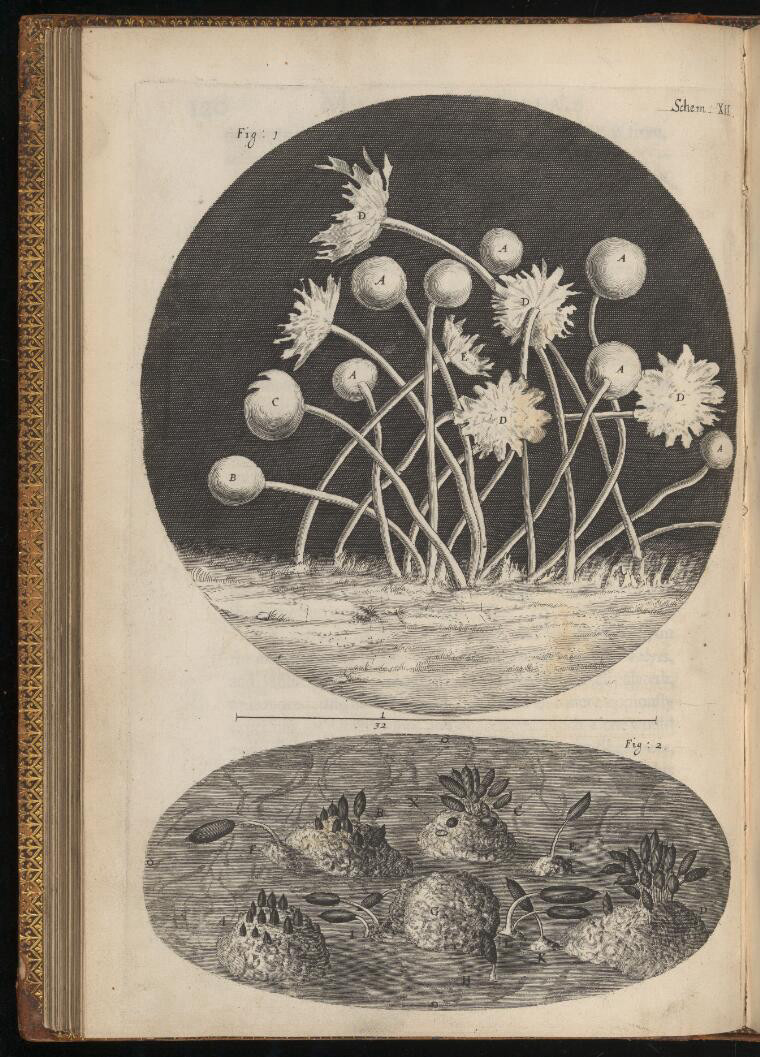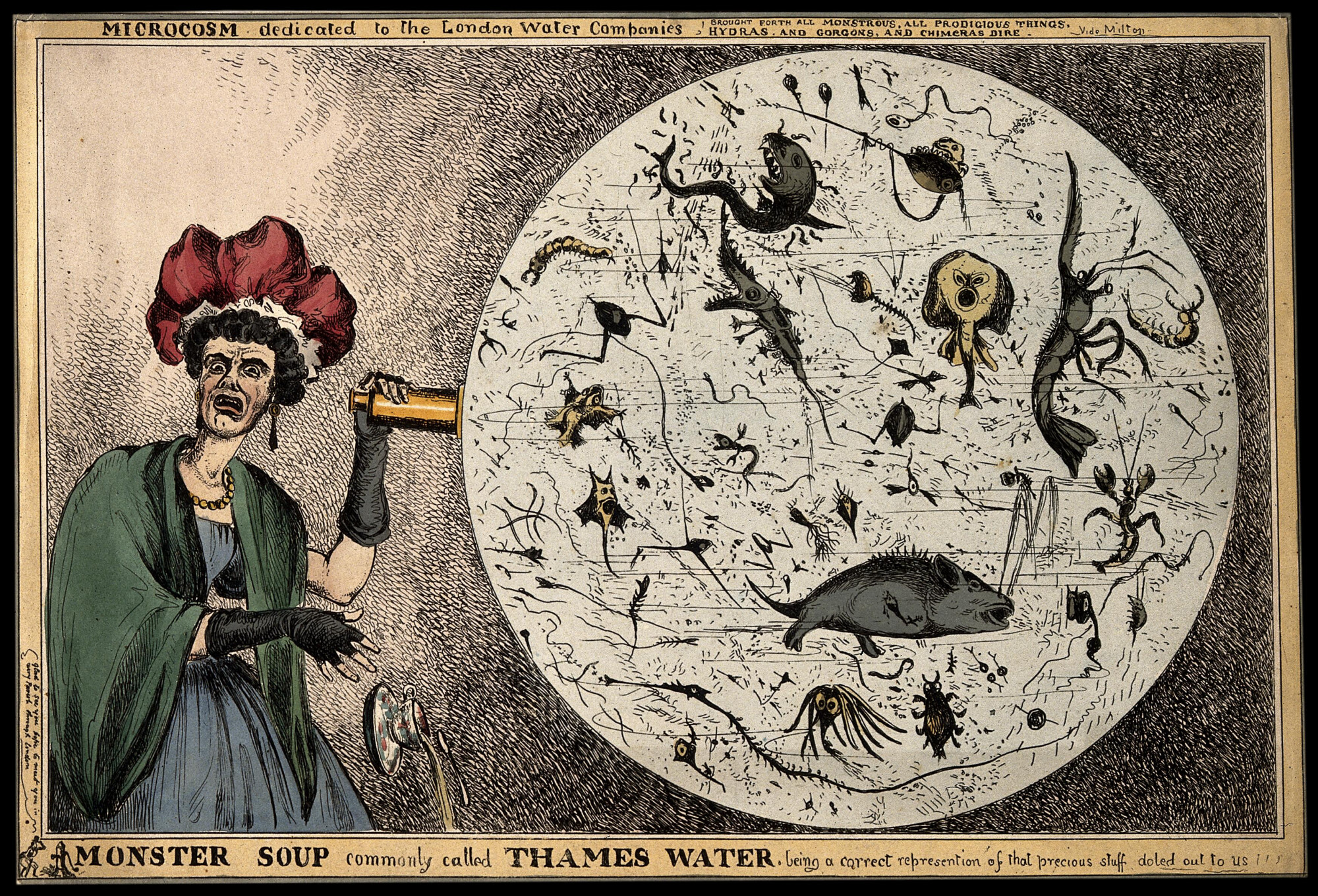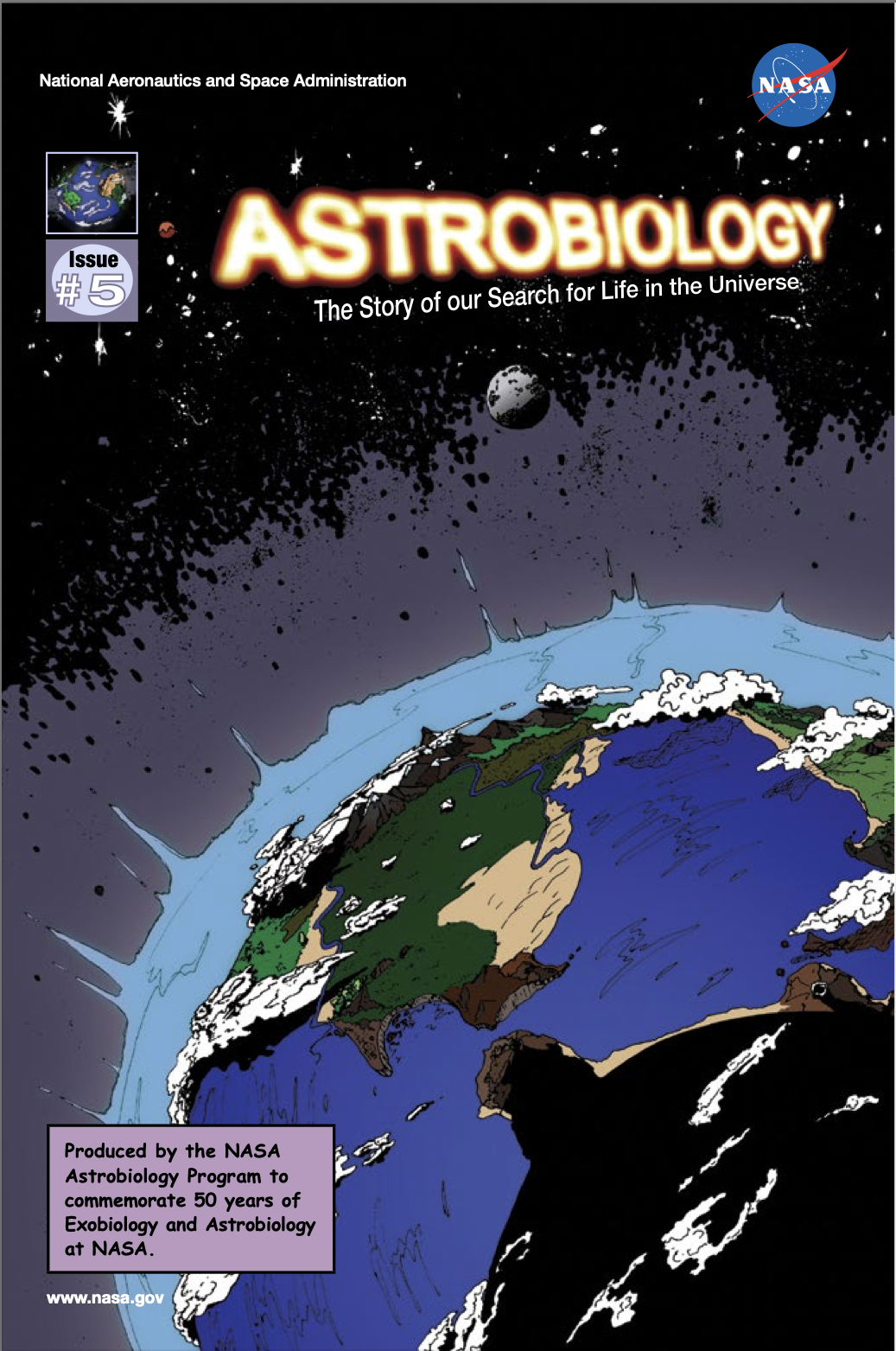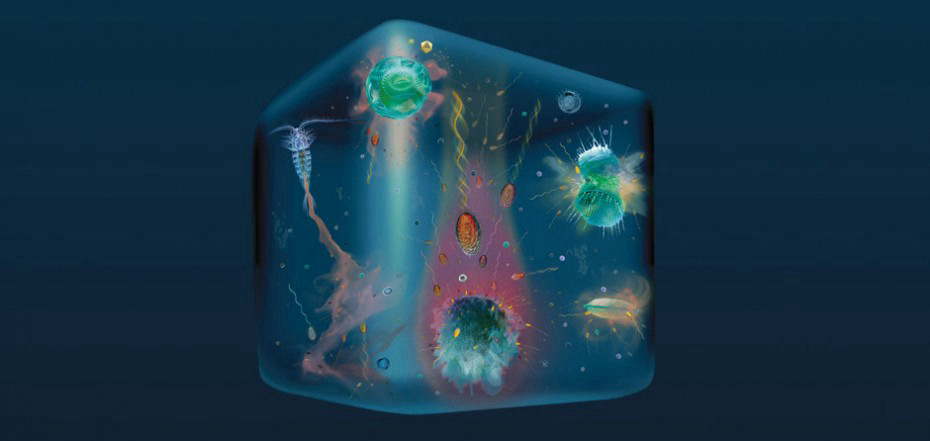
A scientific ‘conversazione’ on microscopy held at Apothecaries’ Hall on 11 April 1855. Engraving from The Illustrated London News, 28 April 1855.1
In the 17th century the first microscopes allowed the earliest glimpses into the world of microorganisms living and thriving just outside the range of our vision. Scientists and lay people alike have been fascinated with these almost invisible worlds. In the beginning microscopy was seen as an erudite endeavour reserved for a closed circle of naturalists. It took a while for these visions to reach broader audiences. But even some of the earliest observers dedicated considerable effort to reproducing their visions in detailed illustrations that circulated beyond their exclusive confines. Over the course of the 19th century, advances in microscopy made these technical apparatuses more readily available. Additionally, printed illustrations became more widely distributed. Soon, the lay public discovered these organisms and a fascination with visions of magical and unknown miniature worlds took hold. As microbes received more and more attention from scientists, their role in many human activities – from brewing, to cheesemaking, to baking – became evident. This was quickly harnessed by various industries.2 At the same time, medical sciences were gradually uncovering the role of microbes in causing diseases and embarked on a massive effort of eradication and containment. Microbes became framed as enemies of humankind.
By the second half of the 20th century the ever-increasing resolution and interconnectedness of scientific visions revealed the centrality of microbial forms of life. This somewhat rehabilitated microbial worlds and contributed to a more benevolent disposition towards microbes.3 We now recognise that microorganisms are essential not only to the history of life on the planet but to the functioning of planetary systems and ecologies on every scale, including our bodies. Without microbes we would not be alive. In accepting this fact, more moderate approaches to working with microorganisms have begun replacing the war-like attitudes of the past. But they continue to require a still growing number of  microscopic media in order to be made visible and intelligible. Microorganisms continue to surprise us and to challenge our received assumptions about life on our planet.4 In particular, throughout the stories told on this website, they challenge our preconceived ideas about
microscopic media in order to be made visible and intelligible. Microorganisms continue to surprise us and to challenge our received assumptions about life on our planet.4 In particular, throughout the stories told on this website, they challenge our preconceived ideas about  what animals can be. They shed light on unexpected ways in which living things can become
what animals can be. They shed light on unexpected ways in which living things can become  objects and data , and how they make natural history. Furthermore, the histories of how microbial worlds went from the unseen background to center stage can help us remember that what we see, and how we see it are deeply interlinked.
objects and data , and how they make natural history. Furthermore, the histories of how microbial worlds went from the unseen background to center stage can help us remember that what we see, and how we see it are deeply interlinked.

Engraving of mould, and magnified view of the surface of a rose-leaf; Schem. 12. From Micrographia: or Some Physiological Descriptions of Minute Bodies Made by Magnifying Glasses with Observations and Inquiries Thereupon by Robert Hooke, Fellow of the Royal Society, 1665. (Wellcome Collection. CC BY SA)
From Fairies to Cells
Before the 19th century, the observation of microorganisms was carried out by inquisitive naturalists and polymaths who often developed their own instruments. Pathfinders like Antoni van Leeuwenhoek, Robert Hooke, and Francesco Redi drew detailed illustrations of the microscopic organisms they observed through makeshift devices. These early illustrations circulated mainly in scientific and intellectual circles, such as early scientific societies and similar institutions.5 At first the world of science struggled to make sense of these life forms, as is detailed, for example, in  Early Micropaleontology. When microscopes became more readily available and more accurate after the introduction of achromatic lenses in the 1830s,6 a broader public was let in on the invisible miniature worlds contained in every droplet of water and grain of sand. This coincided with the mass production and reproduction of images and their increased circulation,7 which facilitated the diffusion of peepholes into these microbial worlds. In this early period of modern microscopy, microbes captured the fancies of Victorians who often saw them as real-life incarnations of folktale’s fairies and pixies.8 Concurrently to the spread of such magical views, scientists portrayed microbes as tiny animals worthy of scientists’ attention. Indeed, Christian Gottfried Ehrenberg, one of the most prominent authorities on microbes – or
Early Micropaleontology. When microscopes became more readily available and more accurate after the introduction of achromatic lenses in the 1830s,6 a broader public was let in on the invisible miniature worlds contained in every droplet of water and grain of sand. This coincided with the mass production and reproduction of images and their increased circulation,7 which facilitated the diffusion of peepholes into these microbial worlds. In this early period of modern microscopy, microbes captured the fancies of Victorians who often saw them as real-life incarnations of folktale’s fairies and pixies.8 Concurrently to the spread of such magical views, scientists portrayed microbes as tiny animals worthy of scientists’ attention. Indeed, Christian Gottfried Ehrenberg, one of the most prominent authorities on microbes – or  Infusoria, as they were known at the time – described them as full organisms, complete with multiple digestive systems, in his celebrated monograph published in 1838.9 Over the following decades, a new understanding of the structures of cells began to replace the view of microbes as tiny animals. They were now considered unicellular life forms fundamentally different from animals and yet related to them. This understanding coincided with the diffusion of Darwin’s and Wallace’s theory of evolution, which singled out microbes as remnants of primitive forms of life that populated an ancient past of less evolved forms.10
Infusoria, as they were known at the time – described them as full organisms, complete with multiple digestive systems, in his celebrated monograph published in 1838.9 Over the following decades, a new understanding of the structures of cells began to replace the view of microbes as tiny animals. They were now considered unicellular life forms fundamentally different from animals and yet related to them. This understanding coincided with the diffusion of Darwin’s and Wallace’s theory of evolution, which singled out microbes as remnants of primitive forms of life that populated an ancient past of less evolved forms.10

“Monster Soup commonly called Thames Water”. Coloured etching by W. Heath, 1828. (Wellcome Collection. CC BY SA)
Useful but Dangerous
Since the second half of the 19th century scientific understandings of microorganisms thus began undergoing radical transformations. In many cases, these transformations are still ongoing today. As cell theory shed new light on the functioning of living organisms and their evolutionary interconnectedness, microbes also revealed their  functional importance. This was particularly evident in the context of some age-old industries, like brewing, baking, cheesemaking, and fermentation. The almost magical and alchemical processes at the heart of these activities came under the scrutiny of scientists and their
functional importance. This was particularly evident in the context of some age-old industries, like brewing, baking, cheesemaking, and fermentation. The almost magical and alchemical processes at the heart of these activities came under the scrutiny of scientists and their  microscopic media and were discovered to centrally depend on microbial collaborations.11 Yeasts, bacteria, and other microbes all play key roles in these transformations and modernizing industries were quick to harness these newly discovered microbial processes to advance their production. Together with these early biotechnological mobilisations, microorganisms also came under scrutiny in the medical sciences. There, they were increasingly depicted as the culprits behind all sorts of diseases and illnesses. This view became particularly prominent thanks to the enormous success of pioneers like Louis Pasteur and Robert Koch, who mobilised their knowledge of microbial life in successful battles against diseases, from rabies and anthrax to tuberculosis and cholera.12 Shaping the foundations of contemporary public health, hygiene, and medicine, these protagonists presented microbes as the agents causing diseases. They developed the so-called ‘germ theory of disease’ which still informs current medical practices and popular attitudes. The public received these discoveries as revolutionary because they helped defeat many ailments of modern society. But, despite their still celebrated importance, many of these innovations partook in painting the negative image microbes still suffer from today, for other examples of how animals are given a negative image, see
microscopic media and were discovered to centrally depend on microbial collaborations.11 Yeasts, bacteria, and other microbes all play key roles in these transformations and modernizing industries were quick to harness these newly discovered microbial processes to advance their production. Together with these early biotechnological mobilisations, microorganisms also came under scrutiny in the medical sciences. There, they were increasingly depicted as the culprits behind all sorts of diseases and illnesses. This view became particularly prominent thanks to the enormous success of pioneers like Louis Pasteur and Robert Koch, who mobilised their knowledge of microbial life in successful battles against diseases, from rabies and anthrax to tuberculosis and cholera.12 Shaping the foundations of contemporary public health, hygiene, and medicine, these protagonists presented microbes as the agents causing diseases. They developed the so-called ‘germ theory of disease’ which still informs current medical practices and popular attitudes. The public received these discoveries as revolutionary because they helped defeat many ailments of modern society. But, despite their still celebrated importance, many of these innovations partook in painting the negative image microbes still suffer from today, for other examples of how animals are given a negative image, see  Where the Rats Live. Furthermore, the fame these figures enjoyed consolidated a heroic and individualistic view of the work of scientists – a view that still fuels poor scientific practices and hampers social justice in current technosciences.13
Where the Rats Live. Furthermore, the fame these figures enjoyed consolidated a heroic and individualistic view of the work of scientists – a view that still fuels poor scientific practices and hampers social justice in current technosciences.13

Issue #5 of Astrobiology: The Story of our Search for Life in the Universe, a NASA comic which “explains how astrobiologists explore analog environments on Earth in order to better understand environments that could support life on other worlds like Mars”.14
Microbes’ Worlds
While the success of medical microbiology consolidated the dominance of a pathological view of microbes as causes of diseases, alternative views of microorganisms were already taking shape at the time. These were advanced by, for example, Sergei Nicholaievich Winogradsky and other lesser known scientists who focused on the environmental role of microbial life.15 Studying soils and the ecological action of microbial communities rather than individual microbial species, these scientists anticipated some discoveries of the 20th century with regards to the vital interconnections  of microbes and planets. Yet, despite their groundbreaking work, it was only in the second half of the next century that the environmental relevance of microbial life would gain a hard-won recognition.16 This feat was made possible by transdisciplinary work with the more applied geophysical sciences, evidenced for instance in the experiences of
of microbes and planets. Yet, despite their groundbreaking work, it was only in the second half of the next century that the environmental relevance of microbial life would gain a hard-won recognition.16 This feat was made possible by transdisciplinary work with the more applied geophysical sciences, evidenced for instance in the experiences of  micropaleontology at sea.
micropaleontology at sea.
From the 1960s onwards, a different view of microbes began to consolidate, one that focused on their ecological and biogeochemical roles, displacing the centrality of the human that subtends medicine and its modern anthropocentrism;17 on the changing roles, uses and images of animals, see also the examples of elephant  “Siam”, polar bear
“Siam”, polar bear  “Knut”, gorilla
“Knut”, gorilla  “Bobby” and Berlin’s former
“Bobby” and Berlin’s former  border dogs. Helping this endeavour were novel techniques in genetics, genomics, and the more recent developments of what is sometimes called post-genomics, which contributed to the success of these alternative views of microbial worlds, and blurred the boundaries that define the modern human.18 Attending to microbial life and its ecologies allows scientists to interpret the heartbeat of our planet and ground its complex dynamics over deep geological time scales. But it also challenges received understandings of the relations between such scales, and our role in them. Rather than offering a black and white picture of microbes as either ‘good’ or ‘bad’, the history of how microbial worlds are shaped and understood invites us not to rush to any simplistic plot, and to “stay with the trouble”, as feminist technosciences scholar Donna Haraway puts it. Microbes are complex organisms, and the closer you look, the more sides, versions, and entanglements of what life can be emerge.
border dogs. Helping this endeavour were novel techniques in genetics, genomics, and the more recent developments of what is sometimes called post-genomics, which contributed to the success of these alternative views of microbial worlds, and blurred the boundaries that define the modern human.18 Attending to microbial life and its ecologies allows scientists to interpret the heartbeat of our planet and ground its complex dynamics over deep geological time scales. But it also challenges received understandings of the relations between such scales, and our role in them. Rather than offering a black and white picture of microbes as either ‘good’ or ‘bad’, the history of how microbial worlds are shaped and understood invites us not to rush to any simplistic plot, and to “stay with the trouble”, as feminist technosciences scholar Donna Haraway puts it. Microbes are complex organisms, and the closer you look, the more sides, versions, and entanglements of what life can be emerge.
How we see microbial life also transforms what we see. The emergence of microbiological knowledge made possible the development of specific forms of governance that are attuned to the invisible masses of microbes. Far from being infallible, these attempts at governing microbes are often frustrating because microorganisms continue to change and  transform. This is visible, for instance, in the history of antibiotics: extracted from competitive soil microorganisms, these molecular tools became widespread thanks to human industry and its dreams of continuous growth. On the one hand, they enabled revolutionary changes in agriculture and biomedicine, on the other hand, they transformed the biology of microorganisms themselves and provoked the rise of antibiotic resistance.19 In this sense, the study of microorganisms also keeps challenging the universalizing ambitions of modern technosciences. If microbes rule the planet, they do so in a myriad of forms and ways, which are deeply interconnected, transformative, and easily cross the scales and boundaries we are accustomed to think with. For this reason, microbial worlds continue to retain the magic that fascinated the Victorians, as they refract our view of the world in an always shifting kaleidoscopic multitude of alternatives.
transform. This is visible, for instance, in the history of antibiotics: extracted from competitive soil microorganisms, these molecular tools became widespread thanks to human industry and its dreams of continuous growth. On the one hand, they enabled revolutionary changes in agriculture and biomedicine, on the other hand, they transformed the biology of microorganisms themselves and provoked the rise of antibiotic resistance.19 In this sense, the study of microorganisms also keeps challenging the universalizing ambitions of modern technosciences. If microbes rule the planet, they do so in a myriad of forms and ways, which are deeply interconnected, transformative, and easily cross the scales and boundaries we are accustomed to think with. For this reason, microbial worlds continue to retain the magic that fascinated the Victorians, as they refract our view of the world in an always shifting kaleidoscopic multitude of alternatives.

”A Drop of Ocean” shows the complex micro-level physicochemical interactions of microbes. (Stocker lab.)20
- From “Amateur Microscopists”. National Museums Scotland, no date. https://www.nms.ac.uk/explore-our-collections/stories/science-and-technology/microscopes/microscopes-chapters/amateur-microscopists/ (28.08.2021).↩
- To learn more about the history of biotechnology, see Robert Bud. The Uses of Life: A History of Biotechnology. Cambridge: Cambridge University Press, 1994.↩
- This opposition between an antimicrobial and a promicrobial attitude is particularly evident in the United States, and has been traced, along with its implications, in Heather Paxson. “Post‐Pasteurian Cultures: The Microbiopolitics of Raw‐Milk Cheese in the United States”. Cultural Anthropology 23, no. 1 (2008): 15-47.↩
- See, for instance, the recent paper on the potential of the microbiota for counteracting ageing in a mice experimental study: M. Boehme et al. “Microbiota from Young Mice Counteracts Selective Age-Associated Behavioral Deficits”. Nature Aging 1 (2021): 666-676. https://doi.org/10.1038/s43587-021-00093-9; or the recent publication describing a microfossil believed to have 3.42 billion years in Barbara Cavalazzi et al. “Cellular Remains in a ~3.42-Billion-Year-Old Subseafloor Hydrothermal Environment”. Science Advances 7, no. 29 (2021): 1-9. https://doi.org/10.1126/sciadv.abf3963.↩
- To learn more about the early history of microscopy, watch: Joseph Gall. “Early History of Microscopy”. iBiology, video. https://www.ibiology.org/talks/history-of-early-microscopes/ (28.08.2021); or listen to “A New Visible World: Robert Hooke’s Micrographia”. The Royal Society, audio recording, 17.10.2015. https://royalsociety.org/science-events-and-lectures/2015/10/a-new-visible-world/ (28.08.2021).↩
- On the cultural and scientific history of microscopy, see Jutta Schickore. The Microscope and the Eye: A History of Reflections, 1740-1870. Chicago: University of Chicago Press, 2007; Laura J. Snyder. Eye of the Beholder: Johannes Vermeer, Antoni van Leeuwenhoek, and the Reinvention of Seeing. New York City: WW Norton & Company, 2015; and Marc J. Ratcliff. The Quest for the Invisible: Microscopy in the Enlightenment. London: Routledge, 2016.↩
- See, for instance, the famous essay: Walter Benjamin. The Work of Art in the Age of Mechanical Reproduction. London: Penguin UK, 2008.↩
- On this peculiar Victorian imagination of the microscopic, see Laura Forsberg. “Nature’s Invisibilia: The Victorian Microscope and the Miniature Fairy”. Victorian Studies 57, no. 4 (2015): 638-66. https://doi.org/10.2979/victorianstudies.57.4.03.↩
- To learn more about Ehrenberg’s life you can find a good overview in David M. Williams and Robert Huxley. Christian Gottfried Ehrenberg (1795-1876): The Man and His Legacy. London: Linnean Academic Press, 1998. The introduction is available here: https://ca1-tls.edcdn.com/Special-Issue-1-Christian-Gottfried-Ehrenberg-1795-1876-The-Man-and-His-Legacy-Small.pdf?mtime=20160715141137 (01.07.2021). For a biography in German, see Johannes v. Hanstein. “Ehrenberg, Christian Gottfried”. In Allgemeine Deutsche Biographie 5 [online], 1877: 701-711. https://www.deutsche-biographie.de/pnd118529250.html#adbcontent (01.07.2021).↩
- Darwin’s contributions to microbiology are usually overlooked. See the editorial “Darwin and Microbiology”. Nature Reviews Microbiology 7, (2009): 546. https://doi.org/10.1038/nrmicro2197.↩
- Again, the historical investigations of Robert Bud can help understand better this transformation. Robert Bud. The Uses of life: A History of Biotechnology. Cambridge: Cambridge University Press, 1994; and Robert Bud. Penicillin: Triumph and Tragedy. Oxford: Oxford University Press, 2007.↩
- On the history of medical microbiology, and especially its hegemonic role in comparison to environmental microbiology, see Frederick T. Attenborough. “‘To Rid Oneself of the Uninvited Guest’: Robert Koch, Sergei Winogradsky and Competing Styles of Practice in Medical Microbiology”. Journal of Historical Sociology 25, no. 1 (2012): 50-82. For a reflection on the current implications of this historical dynamic, see Frederick T. Attenborough. “The Singular Case of SARS: Medical Microbiology and the Vanishing of Multifactorality”. PhD diss., Loughborough University, 2010. https://core.ac.uk/download/pdf/288371192.pdf (28.08.2021).↩
- For more critical appraisals of these figures and their roles, see Bruno Latour. The Pasteurization of France. Camebridge: Harvard University Press, 1993; J. Andrew Mendelsohn. “‘Like All That Lives’: Biology, Medicine and Bacteria in the Age of Pasteur and Koch”. History and Philosophy of the Life Sciences 24, no. 1 (2002): 3-36. http://www.jstor.org/stable/23332438 (28.08.2021). Complicating the heroic accounts of Koch’s role in scientific history in particular, by illuminating the specific economic and colonial aspects of his work, are: Christoph Gradmann. “Money and Microbes: Robert Koch, Tuberculin and the Foundation of the Institute for Infectious Diseases in Berlin in 1891”. History and Philosophy of the Life Sciences 22, no. 1 (2000): 59-79. http://www.jstor.org/stable/23332275(26.08.2021); and Christoph Gradmann. “Robert Koch and the Invention of the Carrier State: Tropical Medicine, Veterinary Infections and Epidemiology around 1900”. Studies in History and Philosophy of Science Part C: Studies in History and Philosophy of Biological and Biomedical Sciences 41, no. 3 (2010): 232-240. https://doi.org/10.1016/j.shpsc.2010.04.012.↩
- NASA. Astrobiology: The Story of our Search for Life in the Universe. NASA, 2015. https://astrobiology.nasa.gov/uploads/filer_public/a3/78/a378f1b1-e438-4156-8af2-cf167a545e4a/astrobio_novel_5_firstedition_hires.pdf (28.08.2021).↩
- On Winogradsky and environmental alternatives to medical microbiology, see also Mathias Grote. “Petri Dish Versus Winogradsky Column: A Longue Durée Perspective on Purity and Diversity in Microbiology, 1880s-1980s”. History and Philosophy of the Life Sciences 40, no. 1 (2018): 1-30. https://doi.org/10.1007/s40656-017-0175-9.↩
- On some of these complicated histories, see Filippo Bertoni. “Soiling Mars: ‘To Boldly Grow Where No Plant Has Grown Before’?”. In Thinking with Soils: Material Politics and Social Theory. Juan Francisco Salazar, Céline Granjou, Matthew Kearnes, Anna Krzywoszynska, and Manuel Tironi (eds.). London: Bloomsbury Academic, 2020: 107.↩
- Important in this paradigm shift was the formulation of the so-called “Gaia hypothesis” by Lovelock and Margulis, and the latter’s theorisation of symbiogenesis. You can learn more about this in my story
 Of Microbes and Planets.↩
Of Microbes and Planets.↩ - To read more on post-genomics and its reconfigurations of biology, see Sarah S. Richardson and Hallam Stevens, (eds.). Postgenomics: Perspectives on Biology After the Genome. Durham: Duke University Press, 2015.↩
- To unravel this complex knot of antimicrobial sentiments and industries, and the ways in which modernity reshapes biology in the case of microbes, see Hannah Landecker. “Antibiotic Resistance and the Biology of History”. Body & Society 22, no. 4 (2016): 19-52. https://doi.org/10.1177/1357034X14561341; Hannah Landecker. “Antimicrobials Before Antibiotics: War, Peace, and Disinfectants”. Palgrave Communications 5, no. 1 (2019): 1-11. https://doi.org/10.1057/s41599-019-0251-8; also “Hannah Landecker: The Microbiome After Industrialization”. Lecture at Christian-Albrechts-Universität zu Kiel, 03.02.2021. https://www.youtube.com/watch?v=xC2g2P0Ka1o (28.08.2021); Hannah Landecker and Andrea Núñez Casal. “‘The Biology of History’: Antibiotics, Resistant Bacteria and the Human Effect, an Interview with Hannah Landecker’. Theory, Culture & Society, 16.03.2015. https://www.theoryculturesociety.org/blog/the-biology-of-history-antibiotics-resistant-bacteria-and-the-human-effect-an-interview-with-hannah-landecker (28.08.2021).↩
- Roman Stocker’s lab at ETH Zurich is one of the sites where innovative techniques to image and imagine microbial worlds are taking shape. They combine microbial sciences and microfluidics, the study of physical interactions of liquids at the microscopic scale. See their website to learn more: https://stockerlab.ethz.ch (28.08.2021).↩